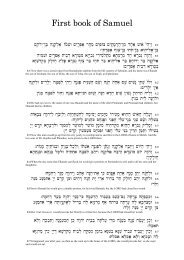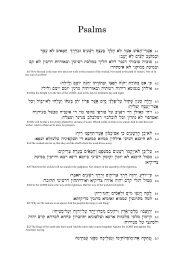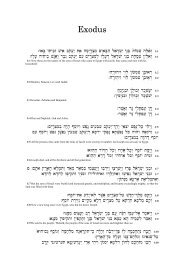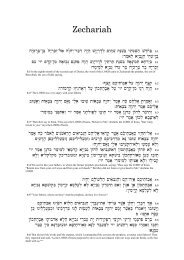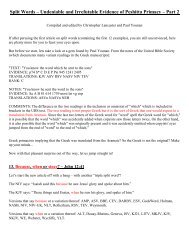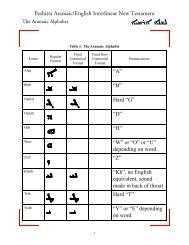ana translation
Untitled - Peshitta Aramaic/English Interlinear New Testament
Untitled - Peshitta Aramaic/English Interlinear New Testament
- No tags were found...
Create successful ePaper yourself
Turn your PDF publications into a flip-book with our unique Google optimized e-Paper software.
Ixviii<br />
INTRODUCTION<br />
more exactly by "JQAlD, retains as an alternative the )OlS of the<br />
A-text which the B-text omits. A like case occurs, 2 Pet. iii. 10,<br />
where the Harklensian, though in its text it adopts the rival reading of<br />
some Greek authorities (/cara/ca^o-eTai for the better attested<br />
which the Philoxenian follows), on its margin<br />
records the<br />
of the latter, but in so doing confirms our A-text by omitting the<br />
negative JJ ( = ov\) which the B-group interpolates<br />
before it. Thus<br />
these two Harklensian notes prove not only (as pointed out in a previous<br />
Section) that the translator had the Philoxenian before him, but<br />
that he had it in the form exhibited by group A, not by group B.<br />
is worth while in passing to remark that in the case of this last-cited<br />
passage, the facts are against Professor Merx's theory in three respects.<br />
For the A-reading (cvpe^aerat without the ofy of B) (1) cannot be<br />
borrowed from the Harklensian, which in its text substitutes<br />
It<br />
Ka.Ta.Ka.rj~<br />
o-erou for evpc^rjo-crai<br />
:<br />
(2) is not contradicted, but supported, by the<br />
Arabic in omitting the negative : (3) is actually attested by the<br />
Harklensian margin where it is placed as an alternative to the reading<br />
of the text.*<br />
Finally, an examination of the MSS discloses other<br />
record as bearing on the matter in hand.<br />
facts worthy of<br />
4. Where the MSS of the A-group show traces, as here and there<br />
happens, of the corrector's hand, the corrections are in the direction<br />
not of the Harklensian, but of the B-text. Even the earliest and best<br />
of them, Cod. 1, has been so dealt with in two places, where a later<br />
hand has introduced B-readings<br />
: 2 Pet. i. 4, f'^^1 (<br />
= rt/xas) ;<br />
and<br />
so 2 Pet iii. 1, ]>.2X ( = KaX^v).f Similarly in Cod. 2, the B-interpolation<br />
(j ( = oux) has been placed in the margin of 2 Pet. iii. 10.J Also<br />
Cod. 20, which, though of fifteenth century, has a text largely coinciding<br />
with A, in three places where it exhibits A-readings inserts the B-<br />
readings in its margin ;<br />
2 Pet. ii. 17 (text, |K\v marg., ^iik)<br />
: ii. 18<br />
(text, WOyt ;<br />
marg., : iii. 16 (text, Ualoi ; marg., ]A*r*)-<br />
la*.Q^<br />
5. Where instances are detected, as admittedly happens now and<br />
* Note that, e contra, the very recent Cod. 19 inserts on its margin the Syr.<br />
equivalent for the KaTOKOTjo-erat of Harkl.<br />
t<br />
See pp. 10, 18, 98, 113 infr.<br />
J See pp. 20, 115 infr. See pp. 142, 143 infr.



